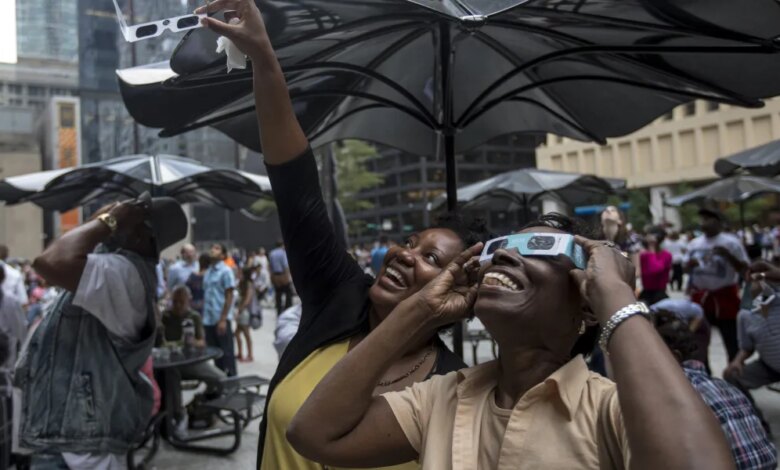What time is total solar eclipse on April 8?


North America is on the verge of another masking of the sun.
Monday’s total solar eclipse will make landfall along Mexico’s Pacific coast and cross into Texas and 14 other U.S. states, before exiting over Canada.
It will last almost twice as long, with an even wider audience, than the total solar eclipse that stretched coast-to-coast in the U.S. in 2017.
The moon will shroud the sun for up to 4 minutes, 28 seconds, a spectacle normally unfolding in remote corners of the globe but this time passing over major cities like Dallas, Indianapolis and Cleveland. An estimated 44 million people live within the path of totality, with another couple hundred million within 200 miles (320 kilometers), guaranteeing the continent’s biggest eclipse crowd ever.
Practically everyone on the continent will get to see a partial eclipse. You can watch the whole thing unfold online, too. NASA is offering several hours of streaming online from several cities along the totality path. The Associated Press will bring live coverage of watch parties and festivities.
And don’t forget your special glasses to safely watch the eclipse.
It all depends on the weather, of course. The National Weather Service is providing daily updates of its cloud cover forecasts along the path.
Here’s more to know about Monday’s celestial showstopper:
What’s a total solar eclipse?
The moon will line up perfectly between the Earth and the sun at midday, blotting out the sunlight. The full eclipse will last longer than usual because the moon will be just 223,000 miles (360,000 kilometers) from Earth, one of the year’s closest approaches. The closer the moon is to Earth, the bigger it is in the sky from our perspective, resulting in an especially long and intense period of sun-blocked darkness. Totality will last the longest over Mexico at 4 minutes, 28 seconds. Elsewhere along the track, like in Syracuse, New York, totality will last just 1 1/2 minutes.
What’s the eclipse path?
The moon’s shadow will slice a diagonal line from the southwest to the northeast across North America, briefly plunging communities along the track into darkness. Totality will enter the continent at Mazatlan, Mexico, and exit at Newfoundland in Canada. In between, 15 U.S. states from Texas to Maine will experience totality, including snippets of Tennessee and Michigan. It will be a repeat for Cape Girardeau, Missouri, and Carbondale, Illinois, which were also in prime position for 2017’s total solar eclipse.
A comet during the eclipse?
During totality, you may be able to spot a comet along with four planets, if you’re lucky. Jupiter will be to the left of the sun and Venus to the right. Saturn and Mars will be to the right of Venus, but fainter. The solar system’s three other planets will be in the vicinity, but virtually impossible to see with the naked eye. Comet 12P/Pons-Brooks is swinging past Earth, as it does every 71 years. Still faint, it will be positioned near Jupiter during the eclipse. But it will take a sudden outburst of dust and gas to see this so-called devil comet without a telescope, according to Anita Cochran of the University of Texas at Austin. But don’t waste time looking for it. “There is lots to see and not that long a time,” she said via email.
Last total solar eclipse in the U.S.?
The U.S. hasn’t experienced a total solar eclipse since Aug. 21, 2017, although a “ring of fire” solar eclipse crossed a part of the country last October. The moon was too far away then to completely blot out the sun, leaving a brilliant, burning ring around our star. The dramatic “ring of fire” stretched from Oregon to Texas, and crossed over Central America and Colombia, before exiting over Brazil. Kerrville, Texas, just west of San Antonio, is back in the bull’s-eye and expecting another packed house.When’s the next one?
After Monday, the next total solar eclipse won’t occur until 2026. But it will graze the top of the world, dipping into Greenland, Iceland and Spain. The next one in 2027 will march across Spain and northern Africa, with totality lasting an incredible 6 1/2 minutes. North Americans will have to wait until 2033 for another total solar eclipse, but it will be limited to Alaska. In 2044, Western Canada, Montana and North Dakota will have front-row seats. And in 2045, the U.S. will once again experience a coast-to-coast total solar eclipse.
Source link




